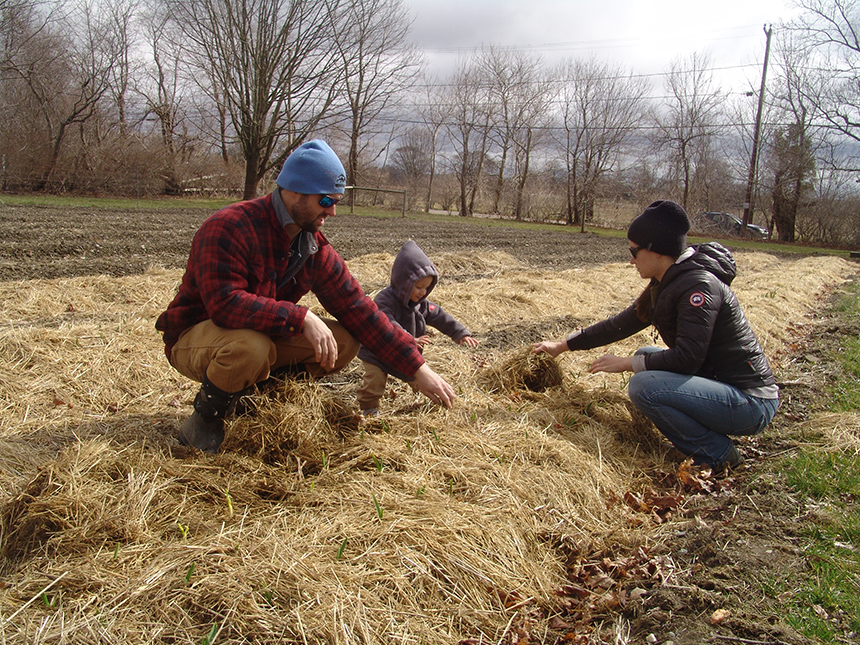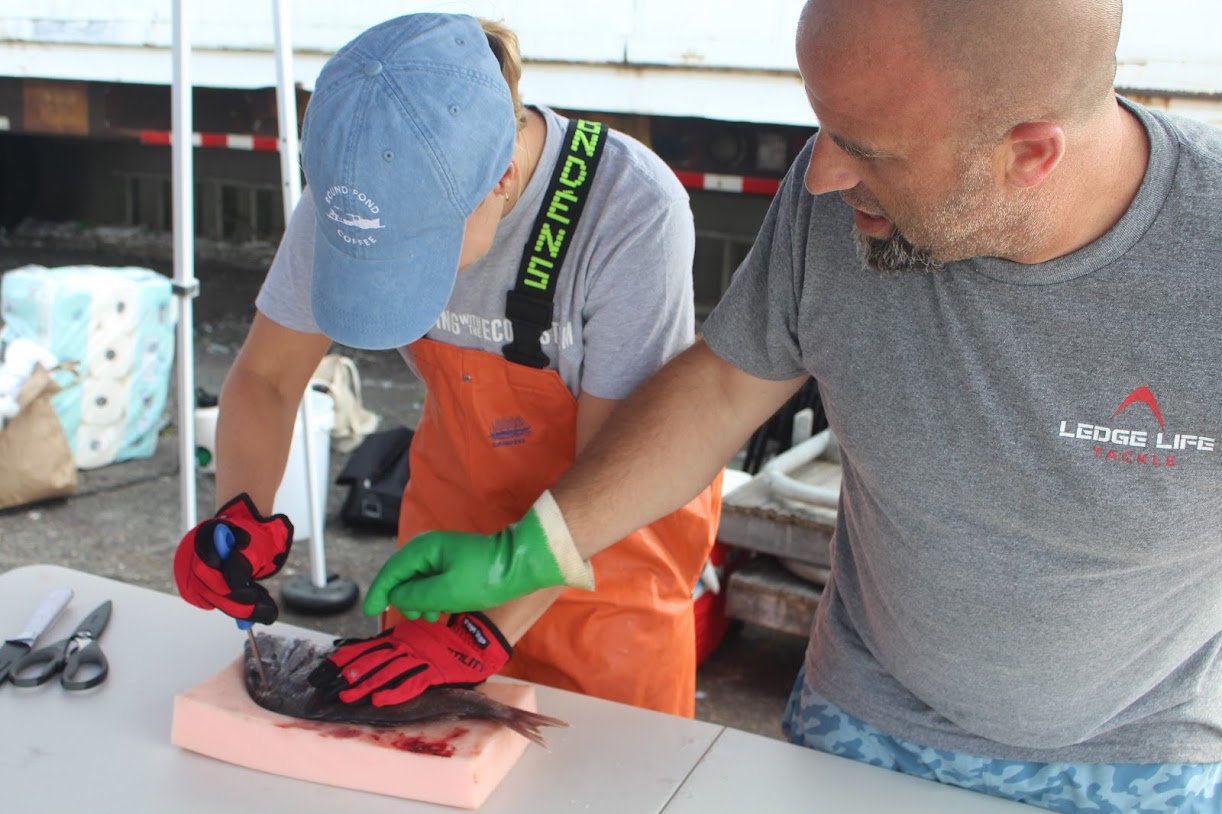They Didn’t Buy the Farm, But They’re Doing the Work
Farming on Aquidneck Island presents a host of challenges, most notably finding affordable land
April 11, 2019
AQUIDNECK ISLAND, R.I. — The work is demanding and tedious. The hours are grueling. And, as an old joke goes, if you want to make a million dollars, start with 2 million.
For those of us hunched over computers, walled off in cubicles, and zombified in meetings, however, farming remains a romanticized profession. But farm to table doesn’t showcase the raw side of the business. The backaches and blisters. The blood, sweat, and tears.
While Rhode Island, thankfully, still has it’s share of historic 1800s homes with big, old barns and their hideaway haylofts, white three-rail fences, red tractors, rolled hay, and green pastures, other farms are nothing more than sun-stroked, wind-battered fields. These farmers commute to work. They push their tractors. They pay rent to weed, water, and cultivate someone else’s land.
But whether you toil away riding a tractor or walking behind one, or own or lease the land, farming is difficult work and it’s financially risky. That combination explains why acres of Rhode Island farmland are being covered with ground-mounted solar panels. It’s why fields and pastures are now being used as event space, rather than to grow food, as an increasing number of farmers, especially older ones, find themselves relying on income that has nothing to do with growing and selling bounty.
Fortunately, there are still people and farms growing food in Rhode Island. Some farmers, such as Jim and Michelle Garman and Amy and Andrew Smith, walked out of classrooms and corporate offices to follow their dream. They don’t for a second regret the decision, but they admit it can be monotonous work.
One must have a significant passion to leave a steady paycheck and work somebody else’s land. The Garmans and Smiths share a fervor for growing food.
Jim, who has a Ph.D. in anthropology, and Michelle Garman, who has a master’s in archeology, left the world of academics behind to pull weeds. Before turning to farming, Jim Garman was a professor in the Salve Regina University History Department. He met his wife of eight years at an archeological dig in Newport.
The couple made the switch to farming for two main reasons: they like eating healthy food and by cultivating their own it enables them to opt out of a “deceptive food system.”
Their standard for selecting the varieties they grow isn’t a plant’s ability to yield or survive disease, but rather how it tastes. The Garmans are constantly searching for hard-to-find tomato varieties, unusual Italian winter squash, and heirloom French lettuces.
Everything they sell — vegetables, fruits, herbs, honey, and flowers — comes from Garman Farm. During the course of the growing season, the farm grows about 40 different crops for its farm share and wholesale customers. The farm specializes in Amish paste tomatoes, Blacktail Mountain watermelon, and Tondo di Piacenza round zucchini. The Garmans have also learned that not everything sells.
“Everyone just assumes that, ‘Well if I can grow it, I can sell it,’” Jim said. “Make sure there are outlets.”
The Garmans also like to experiment, a little anyway. This season, the Garmans, courtesy of a chef’s challenge, will plant artichokes.
They’ve also learned that climate change has impacted what they can grow and when. They have given up planting some cold-demanding spring crops such as spring broccoli. They now grow broccoli, cauliflower, and bok choy in the fall.
“From our very, very micro level of observing climate change, with a few exceptions, it seems to us there is no gradual warm up in the spring, just cold and then hot,” Jim said. “And then some falls that linger much longer than they used to. Climate change is going to be a huge challenge for small growers like us.”
On the other hand, Michelle noted that the region’s changing climate has allowed them to plant things such as okra, some hot pepper varieties, and different kinds of watermelon that they wouldn’t have been able grow eight years ago.

The Smiths worked a combined eight and a half years for corporate America. Since leaving the world of finance, Amy and Andrew Smith have lived and worked on organic family farms in Maine and managed chickens and pigs in Massachusetts. They had a tiny plot in a community garden near the airport when they lived in East Boston, Mass. They now work two fields at The Local Patch in Portsmouth.
Their passion for farming comes from their love of cooking with fresh ingredients and providing people healthy food. They enjoy sharing recipes with farmers market customers and with their community-supported agriculture (CSA) members.
“We thought there was a need for more local and organic produce,” said Andrew, a Rhode Island native who was familiar with Aquidneck Island before he and Amy decided to begin their new life as farmers here. “The ratio of farms to people seemed like it could stand for one more.”
Like the Garmans, the Smiths don’t use chemicals, keep tillage to a minimum, use sustainable practices, and place an emphasis on soil health. Both of the small-scale operations build the soil through a balance of organic nutrients and compost. Both couples also build relationships.
Expensive space
Rhode Island has the most expensive farmland in the United States, at $13,800 per acre, according to the U.S. Department of Agriculture (USDA). The market price, however, is significantly higher, as developers pay as much as 10 times the agricultural value for open space.
This fact is even more profound on Aquidneck Island, where what little open space is left is in high demand. A 2012 USDA report put the average value of an acre of farmland in Newport County’s six municipalities — Portsmouth, Middletown, Newport, Jamestown, Little Compton, and Tiverton — at $22,248.
The Garmans are entering their eighth year renting land, used in the past to grow potatoes and turf, from Aquidneck Land Trust (ALT). Their Middletown farm, which began as a quarter-acre “mental health” oasis, because they both were “pretty stressed out,” is now a 5.7-acre working farm. They live in Newport.
“I don’t know how we’re ever going to be able to buy land on Aquidneck Island. We have to figure that out. That’s where our customer base is,” Jim said. “We’re fortunate to operate on a good lease arrangement with ALT and we’re grateful, but eventually we’d like to have our own.”
“Living and working in separate locations is really difficult in this business,” said Michelle, a Pennsylvania native. “It’s probably one of our biggest frustrations. We’re not there in the morning to see the deer eating our lettuce heads.”
After renting land on Jepson Lane in Portsmouth for two years, the Smiths relocated this year to 2 acres on Wapping Road owned by Aquidneck Farms. They live in Middletown.
The Smiths also found the price for farmland on Aquidneck Island to be eye-opening.
“It’s super expensive,” Andrew said. “The prices aren’t based on the agricultural value; they’re based on the development value. It was really hard to find anything that was even close to affordable.”
It’s also a challenge to find farmland to lease.
“You have to find an organization or individual who has the land and who has the mindset that he wants to host a farm,” Andrew continued. “Some landowners would like to see their land farmed or they have easements on it that it needs to be farmed. But we’re different than just being a hayfield or a pasture. We have our whole business. It’s not just a field of vegetables; it’s everything that goes with it. The washing and harvesting, the storage, our equipment.”
To make it financially as small-scale farmers takes creativity, patience, a plan, and usually an off-farm job.
Michelle Garman works year-round doing software work for a Cumberland company, so she and Jim have health insurance. They have plans to extend their farm’s growing season deeper into the winter with high and low tunnels and growing more storage crops such as winter squash.
In the offseason, Jim Garman, who has two children ages 15 and 13 from a previous marriage, works full time at The Green Grocer in Portsmouth. Andrew Smith works for a construction company in Providence, and Amy works as a personal chef when caring for their one-and-a-half-year-old son Frankie allows it.
“I guess the goal is to carry some vegetables into the winter … through infrastructure like hoop houses and high tunnels or doing more storage crops,” said Amy, a Boxborough, Mass., native. “We toss around that idea a lot, but right now financially, we have to hustle in the winter.”
Jim Garman also noted, in his opinion, it’s important not to go into debt buying equipment you don’t need or taking out loans for such things as operating expenses.
“Every time we’ve contemplated it for a minute, we’ve run away,” said Garman, who advises anyone interested in farming to avoid debt and manage growth slowly. “We’ve been really, really careful to keep the checkbook balanced. We’ve seen it backfire on some farms … every year you’re waiting for your loan to pay off the previous year’s loan. It becomes a cycle.”
Garman, who grew up in Portsmouth and worked on farms when he was in high school, also said you need customer balance. Garman Farm, for instance, sells wholesale to a handful of restaurants and grocery stores, including The Green Grocer, can provide up to 75 CSA shares — it had 55 members last year — and has a booth at the Jamestown farmers market. Jim typically handles the wholesale deliveries and Michelle works the farmers market.
Family plays an important role in the success of both Garman Farm and The Local Patch. Jim’s two sons work the land. Amy’s father and Andrew’s mother are farmhands now. Frankie will be shortly. Neither farm has paid employees, and they are all still learning on the job.
“Stuff happens,” Jim Garman said. “Ultimately, anyone who works with nature has to have a lot of resilience.”



